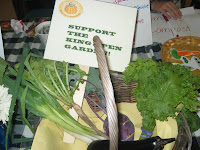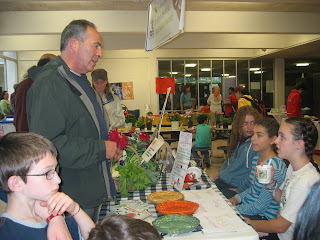 Cleaning Up Along the Mystic River
Cleaning Up Along the Mystic RiverBy Maya
On Sunday, October 4th, two members of the Sprouts of Hope – me and Eliza – participated in the Roots & Shoots’ Mystic River clean up. Cambridge, the city where we live, is part of the the river's watershed, so it was fun to be doing something that helps the river and our community.
When we started, Beth Meserve, who works with MyRWA (the Mystic River Watershed Association) told us about efforts to keep the river clean  and then showed us how she tests the water for various things. In one test, we used PH strips to find out the acidity of the river’s water. We did other tests on water samples to learn about the levels of nutrients and bacteria in the water. She also told us about how volunteers have been collecting water samples every month at 15 locations along the Mystic River -- and testing them -- since 2000. (You can learn more about how MyRWA keeps the river healthy at http://www.mysticriver.org/
and then showed us how she tests the water for various things. In one test, we used PH strips to find out the acidity of the river’s water. We did other tests on water samples to learn about the levels of nutrients and bacteria in the water. She also told us about how volunteers have been collecting water samples every month at 15 locations along the Mystic River -- and testing them -- since 2000. (You can learn more about how MyRWA keeps the river healthy at http://www.mysticriver.org/ criver.org/.)
criver.org/.)
 and then showed us how she tests the water for various things. In one test, we used PH strips to find out the acidity of the river’s water. We did other tests on water samples to learn about the levels of nutrients and bacteria in the water. She also told us about how volunteers have been collecting water samples every month at 15 locations along the Mystic River -- and testing them -- since 2000. (You can learn more about how MyRWA keeps the river healthy at http://www.mysticriver.org/
and then showed us how she tests the water for various things. In one test, we used PH strips to find out the acidity of the river’s water. We did other tests on water samples to learn about the levels of nutrients and bacteria in the water. She also told us about how volunteers have been collecting water samples every month at 15 locations along the Mystic River -- and testing them -- since 2000. (You can learn more about how MyRWA keeps the river healthy at http://www.mysticriver.org/ criver.org/.)
criver.org/.)Watch and listen -- on YouTube -- as Beth tells us about taking care of the river and Eliza and I do some tests.
The water turned out to be pretty clean and healthy, but there was still a lot of trash in and around the river -- and that was what we wanted to clean up. When trash falls into the river, it contributes to make the river less healthy.
We put on boots and gloves grabbed some trash bags and headed of to start the clean up. We found a lot of trash on the streets and parks, so we ended up cleaning more than just the river.
more than just the river.
We put on boots and gloves grabbed some trash bags and headed of to start the clean up. We found a lot of trash on the streets and parks, so we ended up cleaning
 more than just the river.
more than just the river. There were bottles, paper, cigarettes, glass, empty bags of chips, toys, wrappers, straws, cans, and even a tire stuck in the ground. One person found a bike at the bottom of the river. When the clean-up was over, we had so many trash bags filled with trash. We ate donuts and muffins until all the clean-up groups returned.
Then each of us wrote a sentence on a strip of paper about why we were here or what the river means to us. Eliza wrote: "I came because rivers are important." And I wrote that "I hope this river will always be clean." We did this activity so we could help the river and so others could learn about why the Mystic River is so special and why it should be kept clean.
Some people in the neighborhood thanked us for cleaning up their river, and if felt good to help. I hope that the Sprouts can do another river clean up sometime.















